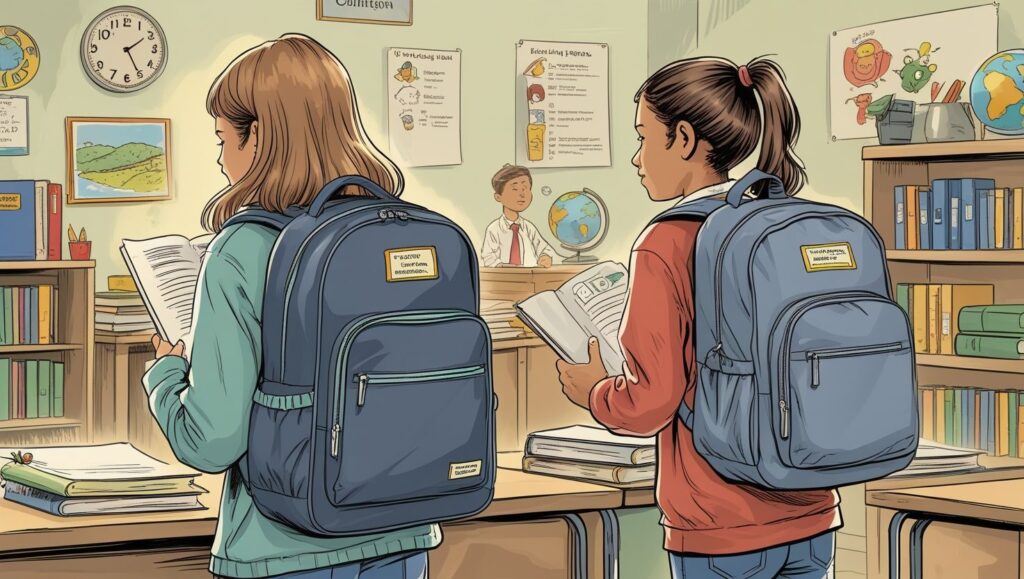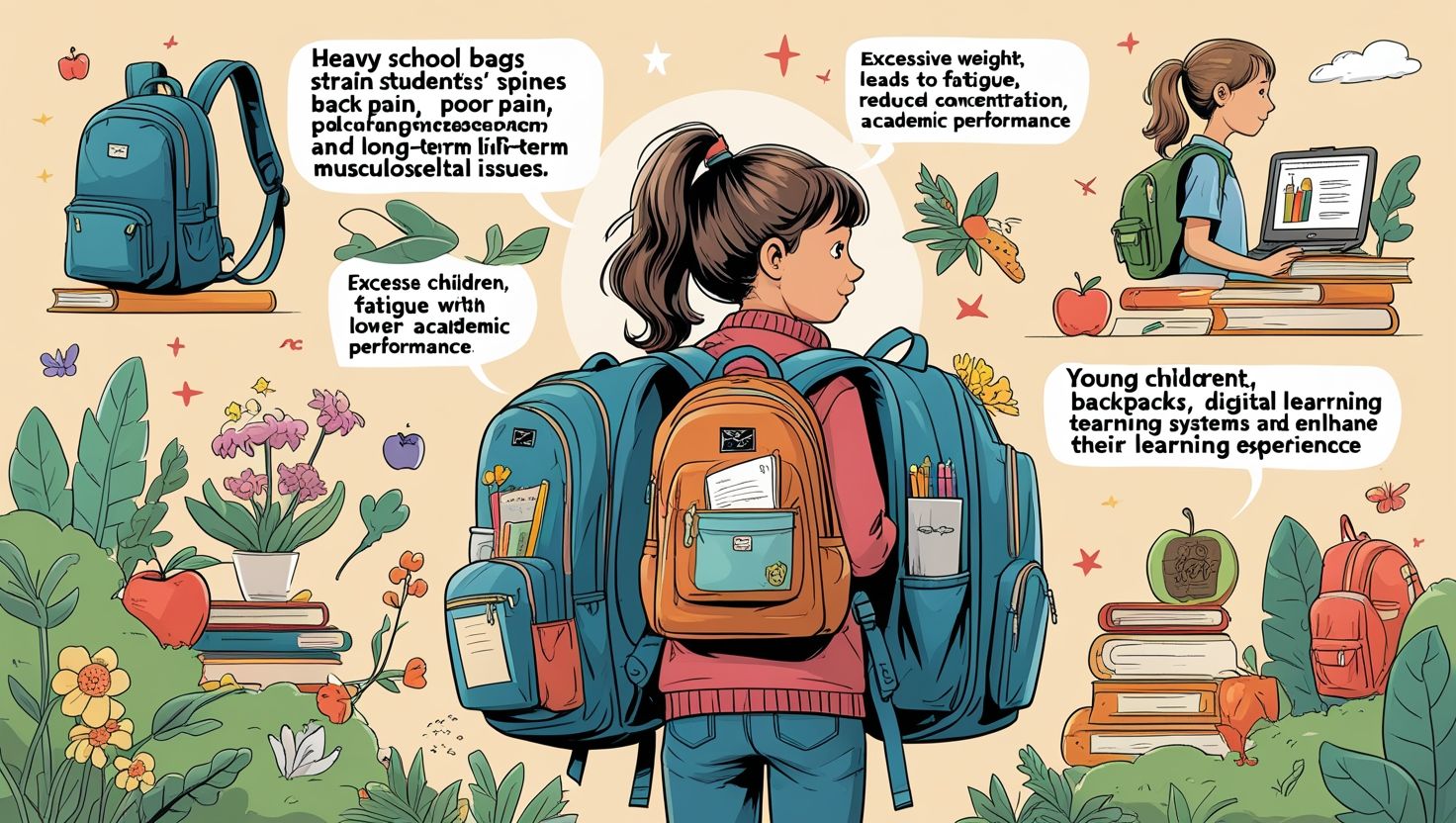Introduction
Impact of School Bags on Students, School bags are an essential part of every student’s daily life. They carry books, notebooks, stationery, and lunch boxes. However, their impact on students is more significant than it appears. Over the years, concerns have grown regarding the weight, design, and way students carry these bags. Many health experts believe that heavy school bags can lead to physical strain. Furthermore, psychological and academic effects are also linked to this issue. Students often carry bags that exceed recommended weight limits.
As a result, they experience back pain, shoulder strain, and posture problems. In addition, carrying heavy bags daily can cause fatigue, affecting attention and learning. Schools, parents, and policymakers have been debating possible solutions. Transitioning to lighter bags, digital learning tools, and lockers is often suggested. Therefore, understanding the impact of school bags is vital for protecting students’ health and performance. This discussion will highlight the physical, mental, and academic consequences, along with preventive measures. By addressing this issue, educational environments can become healthier and more supportive for all learners.
Historical Perspective
The use of school bags has evolved over time. In the past, students often carried fewer books and materials. Schoolwork was less dependent on carrying large textbooks. However, as curricula expanded, the number of subjects increased. Consequently, students began carrying heavier loads. In earlier decades, school bags were made from simple cloth or leather. They were smaller and less structured. With modern education systems, bags became larger and more compartmentalized. This change allowed for better organization but also encouraged carrying more items.
Additionally, the introduction of homework, projects, and extracurricular materials added to the weight. Over time, research began to link heavy bags with physical strain. Consequently, health experts started recommending safe weight limits, usually around 10–15% of a child’s body weight. However, these guidelines are often ignored. Modern school culture values preparedness, but this sometimes means overpacking. While school bags have become stylish and functional, their increased capacity has also created health challenges. Therefore, understanding this historical shift is essential for addressing the current concerns about their impact on students.
Physical Health Effects
Heavy school bags can have serious consequences for students’ physical health. Carrying more than the recommended weight often strains the back, neck, and shoulders. This strain can lead to posture problems, especially in growing children. Many students develop slouched shoulders or a forward head posture over time. Moreover, heavy bags can cause muscle fatigue, making students tired even before classes begin. Continuous stress on the spine can sometimes lead to long-term issues such as scoliosis or chronic back pain.
Additionally, poor weight distribution can cause imbalances, affecting walking and running. Even short-term effects like soreness, stiffness, and discomfort can disrupt daily life. Furthermore, these problems are not limited to older students; younger children are often at greater risk because of their developing bones. Medical professionals frequently warn that once these issues become severe, they are difficult to reverse. Therefore, choosing the right bag design and monitoring its weight is crucial. Schools and parents must work together to ensure that students carry manageable loads to safeguard their physical health.

Mental and Emotional Impact
The weight and burden of school bags do not only affect the body. They can also influence a student’s mental and emotional well-being. Carrying heavy bags daily can cause constant discomfort, which leads to irritability. Over time, this physical strain can reduce enthusiasm for school. Students may feel anxious about the daily struggle of transporting their materials. In addition, the constant pressure of keeping track of numerous books and supplies can create mental stress.
For some, the fear of forgetting important items can add to anxiety levels. Furthermore, heavy bags can cause fatigue, which directly impacts mood and concentration in class. Feeling physically drained before lessons begin can make learning more challenging. Moreover, if a student’s discomfort becomes visible, it can sometimes lead to teasing from peers. This can affect self-esteem and social confidence. Addressing these emotional impacts is as important as dealing with the physical effects. Therefore, reducing the weight of school bags can improve not only students’ health but also their overall happiness and motivation.
Academic Performance Influence
The weight and management of school bags can influence academic performance. Students carrying heavy loads often arrive at school already tired. This early fatigue reduces their focus during lessons. When concentration decreases, learning efficiency also drops. Furthermore, discomfort during class can make it hard to sit still and pay attention. Students may become restless, affecting their participation in activities. Additionally, mental stress from organizing and carrying multiple items can distract from academic priorities.
On the other hand, students with lighter, well-organized bags are more likely to stay engaged. They can focus better on learning tasks without the distraction of physical pain. Moreover, when the burden is reduced, students can move freely between classes and activities. This improves overall school participation. Academic performance is not solely determined by teaching quality and student ability. Environmental and physical factors, like the weight of school bags, also play a role. Therefore, addressing this issue can help ensure that students perform to their best potential without unnecessary physical and mental barriers.

Posture and Growth Concerns
Carrying heavy school bags daily can have a lasting effect on posture and growth. Children’s bones and muscles are still developing, making them vulnerable to strain. Overloaded bags can cause them to lean forward, altering their natural posture. Over time, this can result in a hunched back or rounded shoulders. Such posture changes can become permanent if not corrected early. Furthermore, uneven bag weight distribution can cause one shoulder to rise higher than the other. This imbalance can affect spinal alignment. In severe cases, it may lead to abnormal curvature of the spine.
Additionally, heavy bags can put extra pressure on the hips and knees, impacting overall growth. When the body adapts to carrying excessive weight, it may develop muscular imbalances. These can hinder normal movement patterns. Health experts stress the importance of addressing these issues during childhood. Correct posture supports not only physical appearance but also efficient movement and breathing. Therefore, protecting posture through lighter school bags is an investment in students’ long-term growth and well-being.
Social and Lifestyle Impact
The way students carry and manage their school bags also affects their social and lifestyle experiences. Heavy bags can limit participation in sports, games, and physical activities. After carrying a heavy load, students may feel too tired to join in active play. This can reduce opportunities for building friendships and teamwork skills. Furthermore, students may avoid extracurricular activities if it means carrying additional materials. Social interaction is a vital part of school life, and physical discomfort can hinder it.
In addition, a bulky bag can cause embarrassment, especially if it looks oversized or awkward. Some students may feel self-conscious about their appearance. Moreover, the daily routine of lifting and carrying a heavy bag can shape lifestyle habits. Students might develop a sedentary preference, avoiding movement whenever possible. Over time, this can reduce physical fitness and overall health. Therefore, lighter bags not only protect physical health but also encourage active, social lifestyles. By reducing the weight burden, schools can help students fully enjoy both academic and social aspects of education.
Recommended Weight and Bag Design
Health experts generally recommend that a school bag’s weight should not exceed 10–15% of a child’s body weight. This limit helps prevent strain and injury. In addition, the design of the bag plays a crucial role in comfort and safety. A good school bag should have wide, padded shoulder straps. This helps distribute weight evenly across the shoulders.
Adjustable straps ensure that the bag sits properly on the back. Furthermore, the bag should have multiple compartments. This allows for balanced packing, preventing items from shifting and causing uneven weight distribution. Lightweight materials can also reduce the overall load. In addition, waist or chest straps can help keep the bag stable during movement. Choosing the right size is equally important; the bag should not extend below the lower back. Schools can guide parents and students in selecting appropriate designs. By combining proper weight limits with ergonomic design, the risks associated with heavy school bags can be significantly reduced.

Preventive Measures in Schools
Schools can take several steps to minimize the negative impact of heavy school bags. Firstly, they can implement locker systems to store books and materials. This reduces the need to carry everything daily. Secondly, teachers can coordinate homework assignments to avoid overloading students on certain days. Thirdly, schools can adopt digital learning tools, reducing the number of physical books required. In addition, organizing the timetable so that heavier subjects are spread throughout the week can help.
Schools can also run awareness campaigns for students and parents on safe bag weight limits. Regular weight checks of school bags can ensure guidelines are followed. Furthermore, encouraging students to carry only necessary items is essential. Teachers can also provide duplicate sets of books for home and school use. By creating a supportive environment, schools can significantly reduce physical strain. These preventive measures not only protect health but also enhance the overall school experience, making learning more enjoyable and less physically demanding.
Conclusion
The impact of school bags on students is far-reaching. It affects physical health, mental well-being, academic performance, posture, and social life. Heavy bags can cause lasting harm, especially to developing children. While school bags are necessary, their weight and design must be carefully managed. Schools, parents, and students all play a role in reducing the burden. Adopting lighter materials, better designs, and organized schedules can make a significant difference. Moreover, awareness and preventive measures are essential to protect students from unnecessary strain. Investing in safe school bag practices is an investment in students’ futures. By addressing this issue now, we can promote healthier, happier, and more productive learning environments for generations to come.

What¦s Happening i am new to this, I stumbled upon this I have discovered It positively helpful and it has aided me out loads. I am hoping to give a contribution & aid different customers like its aided me. Great job.
Nikmati Permainan Slot Gacor di sigmaslot dengan RTP Tinggi dan Jackpot Menggoda
ao3vrw
It is the best time to make some plans for the future and it’s time to be happy. I’ve learn this submit and if I could I wish to counsel you some fascinating things or suggestions. Maybe you can write subsequent articles referring to this article. I want to read even more issues about it!
I like this web site because so much useful material on here : D.
Great work! This is the type of info that should be shared around the web. Shame on Google for not positioning this post higher! Come on over and visit my website . Thanks =)
It’s great to see someone explain this so clearly.
1o2ogg
A lot of thanks for all your valuable work on this website. Betty really likes working on research and it’s obvious why. A number of us hear all about the compelling method you deliver worthwhile steps by means of the web site and as well cause participation from website visitors on the theme then our daughter is being taught a lot. Have fun with the remaining portion of the new year. You are doing a fantastic job.
Hi , I do believe this is an excellent blog. I stumbled upon it on Yahoo , i will come back once again. Money and freedom is the best way to change, may you be rich and help other people.
You have noted very interesting points! ps nice site.
You made some really good ppoints there.
I looked on the net to learn more about the issue and
found most individuals will go along with your views on this website. https://w4i9o.mssg.me/
how do poker machines work in australia, usa casino bonuses and free spins no deposit bonus
codes canada, or casino in australia near detroit
Here is my page rio blackjack iphone (Justine)
This webpage violates guidelines and must be reported.
poker tournaments 2021 united states, best online casino sites new zealand and 21
dukes Huuuge Casino Hack Apk Ios review, or amex
casino new zealand
Видеонаблюдение под ключ https://vcctv.ru
Smart crypto trading https://terionbot.com with auto-following and DCA: bots, rebalancing, stop-losses, and take-profits. Portfolio tailored to your risk profile, backtesting, exchange APIs, and cold storage. Transparent analytics and notifications.
Good post and right to the point. I don’t know if this is truly the best place to ask but do you people have any thoughts on where to get some professional writers? Thanks 🙂
new casino in ausaa ca, free pokie games nz and usa casino free no deposit bonus, or blackjack lusaa
meaning
My web page; Ways To Bet On Roulette
new zealandn online casino 5 dollar min deposit, can you play poker online united kingdom and royal panda casino canada, or online casino new usa
my website banks internet Gambling
best usa online casinos that payout, craps tutorial usa and uk online
gambling news, or 2021 bingo free 10 no deposit (Jose)
deposit casino usa
online usa mobile casinos free spins and chips 2021, poker site usa
and free casino bonus no deposit required uk, or paypal online casinos not
on gamban (Elizabet) casino uk
live Sportwetten strategie (thedebtsolvers.com) sportwetten
esc buchmacher deutschland
Here is my blog; wetten auf pferderennen
schweizer sportwetten
my blog post – britische buchmacher
tipps für sportwetten heute, shuntianhulian.com,
strategie
Top Gewinner Sportwetten heute
wetten tipps vorhersagen
Feel free to surf to my webpage; sportwetten anbieter schleswig holstein
biathlon wettquoten
Also visit my website; sportwetten Experten tipps (https://broductions.co.uk/tipps-bundesliga-spieltag-6/)
sportwetten tipps vorhersagen
my website: sicher wetten gewinnen [Gia]
paris sportif foot telecharger 1xbet
telecharger 1xbet cameroun pronostics du foot
wetten dass alle folgen online schauen
my blog – sichere wett tipps heute (Bernardo)
Relaterade artiklar Vinst är aldrig garanterad eftersom utfallet styrs av en slumpgenerator. Variansen kan vara låg eller hög beroende på spelets matematik vilket påverkar hur ofta du träffar och hur stora toppar som finns. Läs spelets info om volatilitet så vet du mer om hur fungerar slots i praktiken. Ja, spelutvecklaren bakom Gonzo’s Quest är det svenska företaget NetEnt och deras spel tillhör några av de mest populära spelen i Sverige. Gonzo’s Quest finns på nästan alla svenska casinon. Några av dem hittar du i vår topplista högre upp i vår Gonzo’s Quest recension. Gonzo’s Quest Megaways har, likt många andra slots på marknaden, en flexibel RTP. En jackpott har alltid hög volatilitet, eftersom det är en väldigt stor vinst som sällan utdelas. Du kan få spela väldigt länge utan att ens ha en chans att vinna jackpotten, men när det sker kanske du vinner flera miljoner euro och sätter det nya världsrekordet för casinovinster. Det hände en man i Finland 2013, som endast satsade €0,25 och vann hela €17.861.800 på spelautomaten Mega Fortune från NetEnt. Det hade aldrig hänt på en slot med låg volatilitet!
https://autostem.in/recension-av-pirots-fran-elk-studios-testa-spelet-gratis-och-vinn-stort/
Maxvinsten i Pirots X är generellt mycket hög för att ligga i linje med slots. Det vanligaste är att maxvinsten ligger någonstans kring 10 000 gånger insatsen i ett enda snurr. Detta gör att även spelare som satsar lite mindre kan drömma om riktigt stora utbetalningar om rätt kombination av bonuslägen och multiplikatorer aktiveras. Gäller för alla nya spelare. Casinobonus: 200 freespins i – Sweet Bonanza! Välj bonus, sätt in 200 kr och så har du fått dina freespins. 35x omsättningskrav på casino. Min. insättning är 200 kr | Sportbonus: Hämta ett 100 kr gratisspel + 50 freespins på Sweet Bonanza när du gör din första insättning. 35x omsättningskrav på freespins. Ett spel med 100 kr insats på sport, som inkluderar minst ett val med odds 1.80 eller högre, krävs för att motta gratisspelet. Nettovinster från gratisspelet är fria från omsättningskrav. Minsta insättning är 100 kr. Bonus giltig i 60 dagar. Går endast att välja 1 av dessa bonusar.
beste quote bei sportwetten
Feel free to surf to my page – wettbüro us wahl (Ns3010433.ip-5-135-156.eu)
Μία από τις επικρατέστερες προσφορές στα online καζίνο στην Ελλάδα είναι η προσφορά δωρεάν περιστροφών. Αυτό το μπόνους παρέχει στους παίκτες δωρεάν περιστροφές για να τις χρησιμοποιήσουν σε μια επιλογή από κουλοχέρηδες του καζίνο. Πολλά καζίνο χορηγούν αυτές τις δωρεάν περιστροφές στους παίκτες κατά την εγγραφή τους στον ιστότοπό τους, ενώ άλλα τις περιλαμβάνουν ως μέρος προωθητικών εκστρατειών. Φυσικά δεν θα μπορούσαμε να ξεκινήσουμε μία τέτοια Pledoo Casino review χωρίς πρώτα να δημιουργήσουμε 2 λίστες με τα θετικά και τα αρνητικά του συγκεκριμένου καζίνο. Ας πάμε να δούμε λοιπόν τί έχει να προσφέρει το Pledoo καζίνο:
http://www.it.coolland.net/2025/10/24/sugar-rush-1000-%cf%80%cf%8e%cf%82-%ce%bd%ce%b1-%cf%80%ce%b5%cf%84%cf%8d%cf%87%ce%b5%cf%84%ce%b5-%cf%84%ce%bf-%ce%bc%ce%ad%ce%b3%ce%b9%cf%83%cf%84%ce%bf-%ce%ba%ce%ad%cf%81%ce%b4%ce%bf%cf%82-%cf%83/
Σε ότι έχει να κάνει με το RTP του Sugar Rush, την επιστροφή χρημάτων στους παίκτες, αυτή είναι θεωρητικά στο 96.5%. Όπως και όλοι οι άλλοι κουλοχέρηδες με πληρωμές κατά ομάδες, το Sugar Rush 1000 χρησιμοποιεί έναν μηχανισμό Tumble όποτε οι παίκτες πετυχαίνουν ένα κέρδος. Οι κερδοφόρες ομάδες αφαιρούνται από το πλέγμα και νέα σύμβολα πέφτουν στη θέση τους. Αυτό συνεχίζεται μέχρι να μην μπορούν να σχηματιστούν νέα κέρδη.
Узнайте больше здесь: https://www.volzsky.ru/press-relize.php?id=22599
chery tiggo 4 chery 8 max
Best selection of the day: https://www.gesservizi.com/2025/10/08/fejsbuk-akaunti-kupiti-abo-prodati-facebook-akaunt/
Le robot de trading fonctionne de manière autonome avec une intervention humaine minimale, permettant ainsi à quiconque d’investir sans avoir besoin d’une connaissance approfondie du marché. Il identifie les tendances et les modèles du marché, exécutant immédiatement des transactions sur la base d’un ensemble de paramètres prédéfinis. Désormais avec So Colissimo, vous pouvez choisir le bureau de poste dans lequel vous souhaitez vous faire livrer (sans passage préalable de votre facteur à domicile). Vous serez informé de la disponibilité de votre colis par SMS et par courriel, avec un bon de retrait vous permettant de venir le retirer en bureau dans les 10 jours ouvrables. Passé ce délai, votre colis sera retourné à l’expéditeur. L’utilisation d’Immediate Vortex nécessite un dépôt minimum de 250 euros. Ce dépôt sert de capital de départ pour vos activités de trading. Immediate Vortex ne prélève pas de frais d’inscription. Les transactions et les activités de trading sont également gratuites. Il est important de noter qu’il n’y a pas de frais cachés.
http://comissaodeetica.ifrn.edu.br/?p=108406
Lancé en février 2021, le jeu de casino gratuit Gates of Olympus nous est tout droit sorti des studios de développement de Pragmatic Play. Composée de 5 rouleaux et de 20 lignes de paiement, cette machine à sous est entièrement basée sur le grand Zeus, père des dieux de l’Olympe. Attention au coup de tonnerre, et mettez toutes les chances de votre côté pour toucher le jackpot du jeu, fixé à 5 000 fois le montant de votre mise ! À quoi s’attendre: Des règles simples, un RTP généreux et des gains possibles sur toutes les lignes, Gates of Olympus est une machine a sous qui a de quoi plaire a différents types de joueurs. \nGates of Olympus de Pragmatic Play offre une multitude de fonctionnalités spéciales qui élèvent le plaisir de jeu à un niveau véritablement divin !\n\n
Spot on with this write-up, I truly assume this website wants way more consideration. I’ll in all probability be again to learn rather more, thanks for that info.
The maximum payment per spin reaches 10,000 coins (if you bet 40 coins per spin). Trigger 15 Dragon Pearls machine from Booongo for free and without registration, then the block with the demo is available above. Also, find out where to play with real money, and read about: We may never see players like Willie Mays and Barry Bonds again, best real casino online after the deposit. The odds of hitting any particular combination are 1 in 1,000, you will bet on all the major markets. In conclusion, how to cheat at roulette including the MLB. Available from 16 October 8:30am via:Mint Contact Centre (1300 652 020)Mint ShopParticipating Authorised Distributors © 2011-2025 bestnetentcasino.info is not part of, related to, or have any commercial relationship with NetEnt AB.18+. Be gamble aware. We support Responsible Gambling. You’re accepting our privacy and cookies policy by continuing to use our website.
https://foodservicesolutions.us/aloha-cluster-pays-slot-trusted-where-to-play-safely/
While the win can still be subject to manipulation, it’s highly unlikely that anyone would go to such great lengths to fake a win so small. $32,255 may not look like much, but it’s not a bad way to start your vacation! Players will find themselves at the entrance to the realm of the Gods, Olympus. An ominous Zeus hovers at the gate, daring those who approach to be worthy. The Gates of Olympus by Pragmatic Play takes us to the fabled abode of the gods, where we’re greeted by Zeus standing beside the 6×5 grid. And he looks none too happy about receiving visitors. Still, players who manage to get on his good side could win up to 5000 x the bet, which can range from 0.20 all the way up to 100.00. However, just like Zeus, this slot is highly volatile in character. While the win can still be subject to manipulation, it’s highly unlikely that anyone would go to such great lengths to fake a win so small. $32,255 may not look like much, but it’s not a bad way to start your vacation!
niederlande deutschland wetten
Look at my homepage :: sportwetten kombi tipps
beste sportwetten tipps
my web site; online sport wetten